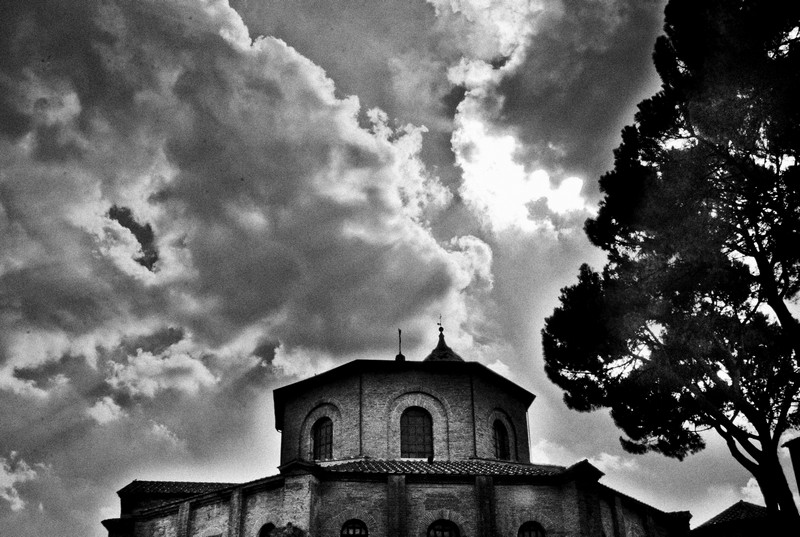


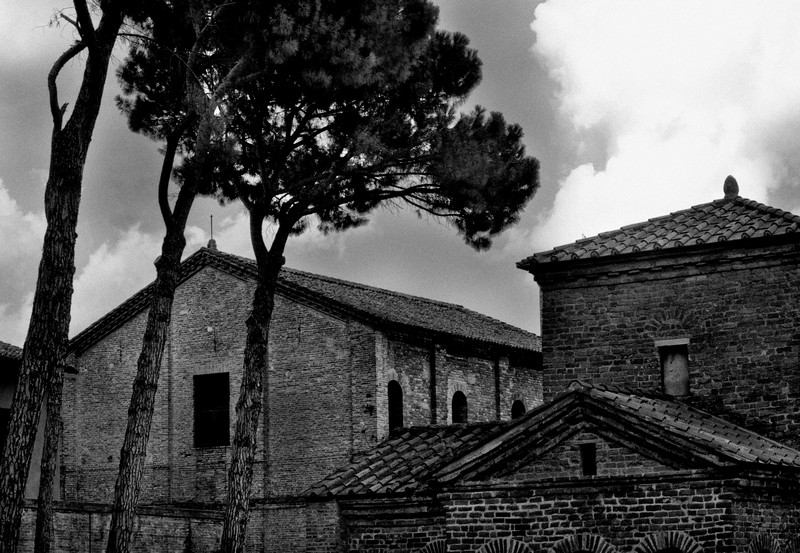
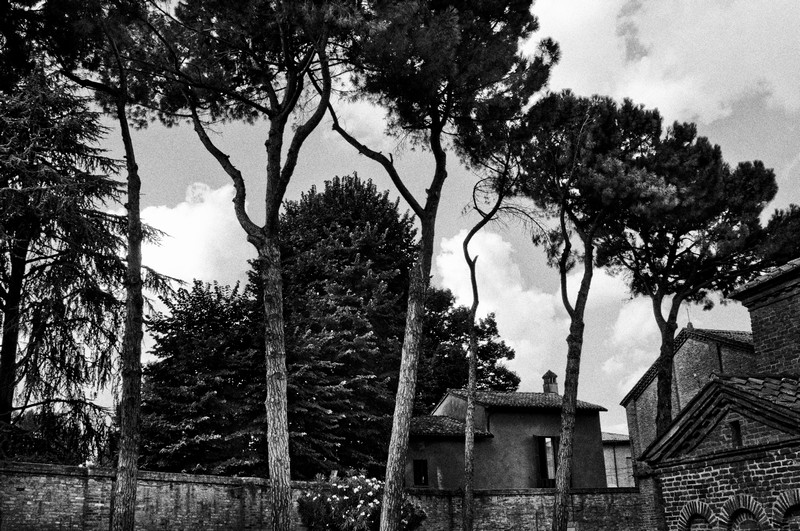

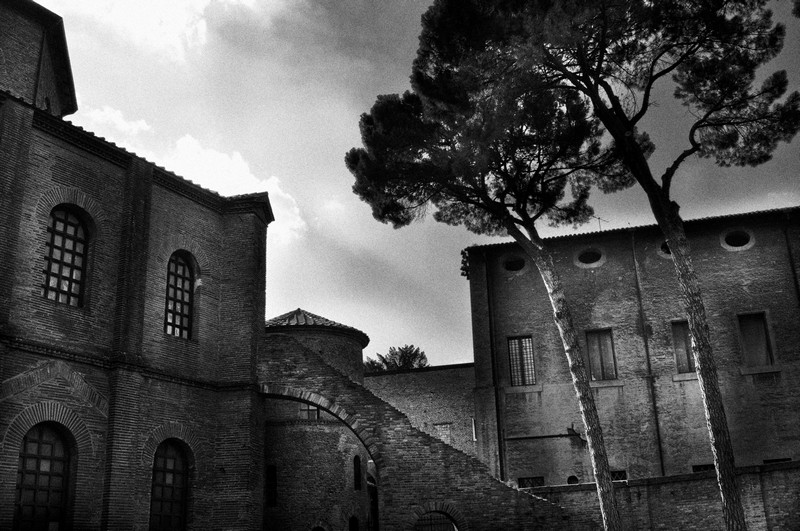
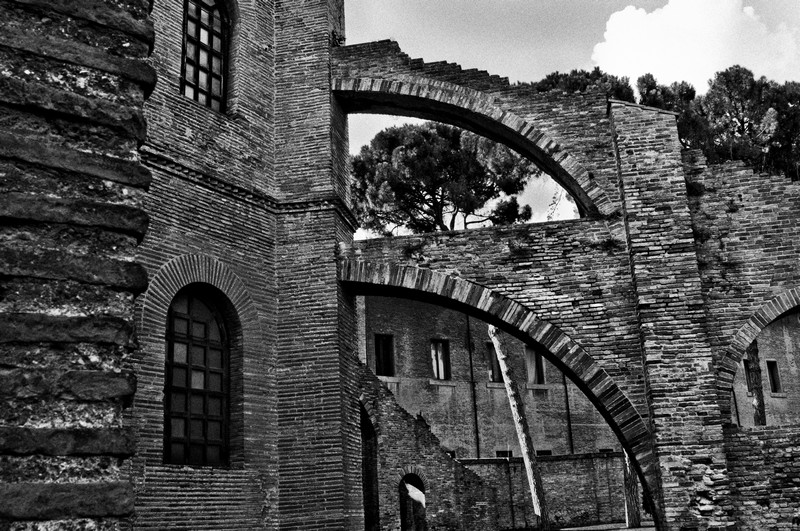
i find the contrast between this stark exterior of the monuments and the lavishly decorated Byzantine mosaics in the interior breathtaking.
below i include Carl Gustav Jung's account of his mysterious experience when visiting the mosaics, in 1933.

Even on the occasion of my first visit to Ravenna in 1913, the tomb of Galla Placidia seemed to me significant and unusually fascinating. The second time, twenty years later, I had the same feeling. Once more I fell into a strange mood in the tomb of Galla Placidia; once more I was deeply stirred. I was there with an acquaintance, and we went directly from the tomb into the Baptistery of the Orthodox.
Here, what struck me first was the mild blue light that filled the room; yet I did not wonder about this at all. I did not try to account for its source, and so the wonder of this light without any visible source did not trouble me. I was somewhat amazed because, in place of the windows I remembered having seen on my first visit, there were now four great mosaic frescoes of incredible beauty which, it seemed, I had entirely forgotten. I was vexed to find my memory so unreliable.
[There follows a detailed description of the frescoes which i skip]
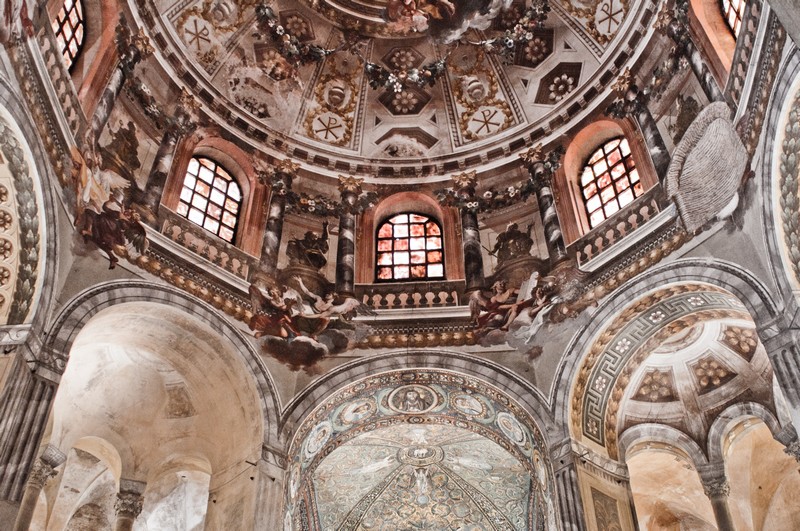

After we left the baptistery, I went promptly to Alinari to buy photographs of the mosaics, but could not find any. Time was pressing this was only a short visit and so I postponed the purchase until later. I thought I might
order the pictures from Zurich.
When I was back home, I asked an acquaintance who was going to Ravenna to obtain the pictures for me. He could not locate them, for he discovered that the mosaics I had described did not exist.
Meanwhile, I had already spoken at a seminar about the original conception of baptism, and on this occasion had also mentioned the mosaics that I had seen in the Baptistery of the Orthodox. The memory of those pictures is still vivid to me. The lady who had been there with me long refused to believe that what she had "seen with her own eyes" had not existed.
As we know, it is very difficult to determine whether, and to what extent, two persons simultaneously see the same thing. In this case, however, I was able to ascertain that at least the main features of what we both saw had been the same.


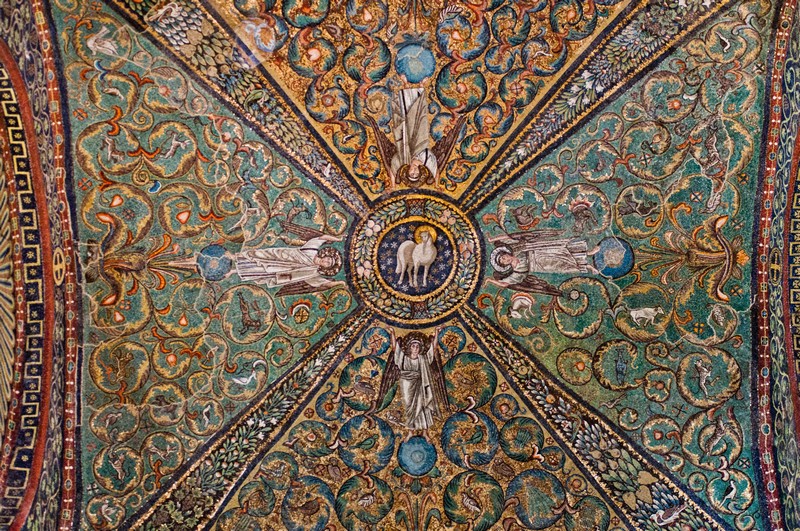
This
experience in Ravenna is among the most curious events in my life. It
can scarcely be explained. A certain light may possibly be cast on it by
an incident in the story of Empress Galla Placidia (d. 450). During a
stormy crossing from Byzantium to Ravenna in the worst of winter, she
made a vow that if she came through safely, she would build a church and
have the perils of the sea represented in it. She kept this vow by
building the basilica of San Giovanni in Ravenna and having it adorned
with mosaics. In the early Middle Ages, San Giovanni, together with its
mosaics, was destroyed by fire; but in the Ambrosiana in Milan is still
to be found a sketch representing Galla Placidia in a boat.
I
had, from the first visit, been personally affected by the figure of
Galla Placidia, and had often wondered how it must have been for this
highly cultivated, fastidious woman to live at the side of a barbarian
prince. Her tomb seemed to me a final legacy through which I might reach
her personality. Her fate and her whole being were vivid presences to
me; with her intense nature, she was a suitable embodiment for my anima.
The
anima of a man has a strongly historical character. As a
personification of the unconscious she goes back into prehistory, and
embodies the contents of the past. She provides the individual with
those elements that he ought to know about his prehistory. To the
individual, the anima is all life that has been in the past and is still
alive in him. In comparison to her I have always felt myself to be a
barbarian who really has no history like a creature just sprung out of
nothingness, with neither a past nor a future.
In
the course of my confrontation with the anima I had actually had a
brush with those perils which I saw represented in the mosaics. I had
come close to drowning. The same thing happened to me as to Peter, who
cried for help and was rescued by Jesus. What had been the fate of
Pharaoh's army could have been mine. Like Peter and like Naaman, I came
away unscathed, and the integration of the unconscious contents made an
essential contribution to the completion of my personality.
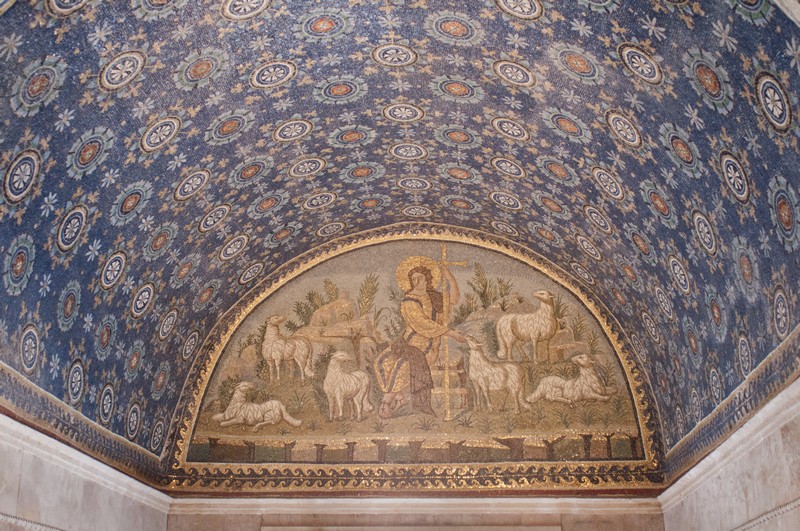
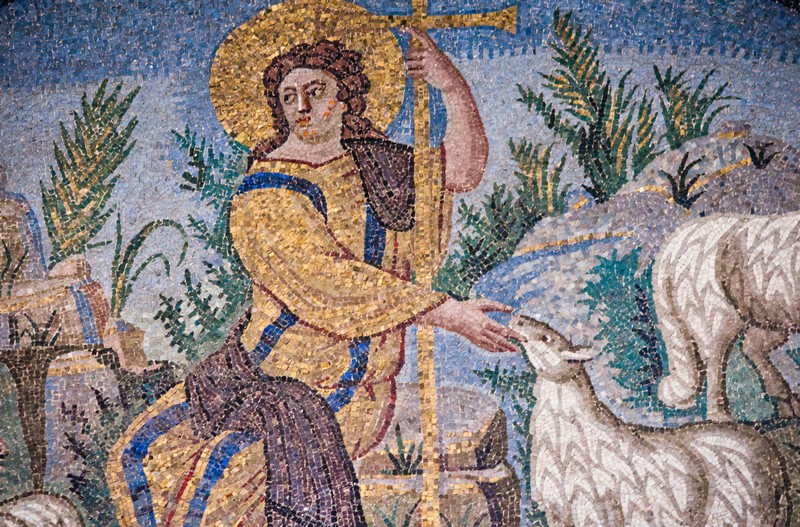

Since my experience in the baptistery in Ravenna, I know with certainty that something interior can seem to be exterior, and that something exterior can appear to be interior. The actual walls of the baptistery, though they must have been seen by my physical eyes, were covered over by a vision of some altogether different sight which was as completely real as the unchanged baptismal font. Which was real at that moment?
My case is by no means the only one of its kind. But when that sort of thing happens to oneself, one cannot help taking it more seriously than something heard or read about. In general, with anecdotes of that kind, one is quick to think of all sorts of explanations which dispose of the mystery. I have come to the conclusion that before we settle upon any theories in regard to the unconscious, we require many, many more experiences of it.
from Jung's Memories, Dreams, Reflections
note: photographs of The Church of San Vitale and the Mausoleum of Galla Placidia

this is an exception to my usual posts, as the photos simply document the monuments, but these are so gorgeous and astonishing that i wanted to share some of my wonder with you - and Jung's vision is fascinating as well, i thought it fits very well on the Bridge of Dreams :-)
ReplyDelete:) da,asa este,astonishing:)si nu trebuia sa pierdem niciuna dintre clipele in care tot universul se pleaca,monumental,pentru a vorbi in piatra si a ne face sa simtim ceva ca un vant de primavara in care toate devin,intr-un fel de nespus,sfinte,sfinte fara emfaza sau exagerare,sfinte stiind totul despre asta.
ReplyDeletepasii se cutremura,asa cred,peste dalele reci si simt acolo intreaga fascinatie a primelor zile,oricare vor fi fost ele
mulţumesc, draga mea, da, nu poţi fi acolo fără cutremur, totul tremură
DeleteIt is so extraordinary the vision and creative energies and the sheer number of hours and days and years it must have taken to create these images and surfaces....
ReplyDeleteexactly my thoughts, Dan! impossible to imagine, and yet they are real...
DeleteIncredible photos, Roxana! Religion continues to fascinate, even after all these years..wouldn't you say?
ReplyDeletethank you, b!
Deletei don't know, i would say, with mythopolis, that what fascinates here is the incredible effort and struggle of imagination and creativity and hard work which made this possible...
1.beautiful. thankyou for sharing my friend.I love these words-I find the contrast between this stark exterior of the monuments and the lavishly decorated byzantine in the interior breathtaking.
ReplyDeleteis it because the latter then takes on an ephemeral beauty like a flower.like the efflorescence of the mind and heart whereas the building gives more of a longstanding impression of stability nonetheless poignant.
perhaps partly because it reminds me of my italian grandfather that was a mason but also a mayor at one time.he suffered an immigrant's suffering and he used to say to me as a young child-they can take away everything from you but what's in here pointing to his head and as I started growing up after he passed away I thought this meant that no one can take your education from you but then I began to think that it meant more than that, and yes there is no citadel that is impenetrable that can't be reached from an exterior incisive angle.
sending you kisses rising like incense haha.
dear Madeleine, your stories, mixed with your impressions about my posts, make a truly interesting reading! :-) and your origins are also a truly interesting mixture, i think this explains, perhaps, your openness towards all cultures and experiences :-)
Deletekisses back!
My heart skipped a beat when I saw that you were visiting Ravenna's mosaics...and I was bewildered and shocked when I arrived to find brooding black and white exterior shots. Then I read your explanation of wishing to showcase the contrasts of exterior and interior, and of course it made sense. The imagery inside the church is stunning. I understand how it would have inspired Klimt's work. I dream of some day visiting Ravenna; thank you for reminding me of this for I had forgotten. And now, after having seen all the lovely interior colourwork, I have a greater appreciation for those moody black and white images with their own detailed textures and lines (my favourite being the second from last of that series).
ReplyDeleteoh Lynne, so you knew about the mosaics, and you got a shock when you arrived on the Bridge haha - i am still laughing about this :-) but no, it would have been impossible to not post about the mosaics themselves, and to not do this in colour (though i find the interiors in bw are very beautiful as well). and Klimt!!! i had found out about Jung and Ravenna, but this Klimt connection had escaped me, how interesting, but of course it makes perfect sense. and yes, you _must_ come and see in person, words and images cannot match the real thing here...
DeleteMore holiday snaps of Poland?
ReplyDeleteBut i am not surprised that the Polish psychotherapist Jung (Swiss you say!) was attracted to these mosaics. The human psyche is always a question of the whole being greater than the sum of its parts.
Incidentally, mosaics are always good in color and trees in black and white. (She will get out her old psychoanalytic text books and search for hidden meanings in this bold assessment.)
i have a _sea_ of holiday snaps of Poland, though unfortunately a certain Bridge has escaped me, even if very famous there :-P
Delete(Jung was also very interested in alchemy, as certain magicians, but i am sure you know that too! :-)
ich will nicht viele worte verlieren. die bilder sind sehr berührend und gehen mindestens mir sehr nahe und viele jahre ist es her, da erlebte ich etwas ganz besonderes in und ausserhalb dieser kirche und die erinnerung ist wieder ganz wach, dank dir... http://commons.wikimedia.org/wiki/File:Valcabr%C3%A8re_basilique_Saint-Just_%281%29.JPG
ReplyDeletealles liebste von den sich immer wandelnden wolken. renée
ah, Du hast eine besondere Erfahrung in einer Kirche gemacht, wie neugierig ich geworden bin, Du musst mir das mal erzaehlen!!!
Deleteich schicke Dir ein schoenes warmes Laecheln und schreibe Dir bald, liebste Wolkenprinzessin! :-)
this is beyond astonishing and any dream. I feel I was there, with you, touching the cold mosaics.
ReplyDeletei wish you could have been there.
Delete2. hi my beautiful friend.I love sacred art- the last one is hypnotic.as if a universal force has been tapped.and that's the essence of sacred art - a journey to the source to the creation of man which is the exaltation of the source within and actually for me all art is sacred actually because the individual is tapping his creative essence which flows through the cosmos and for each individual it is a unique exaltation like the stars of sagittarius shinning brilliantly like strings of dna. {I cant believe I said that but I am on the bridge so anything is possible haha.)
ReplyDeletehere is a little side wink. I have my own flock of sheep-comprising my organic mattress and I am so grateful.I breath so much freer thanks to them.{I cant beleive I said that haha.
starlit kisses to you my friend.
and Madeleine, i knew you would like this, as i know of your fascination with sacred art :-)
DeleteA highly successful presentation. So many patterns and textures of ancient stones and mosaic cut and place by long gone artisans' hands. Yet all is still so alive. The moody exterior, the clouds, the tall slender trees. Onto the earth-toned cavernous interior spaces; I like the symmetry. The patterns and details are mind-boggling. The trajectory of humanity is terrifying and beautiful...
ReplyDeleteoh Stickup, you said it all here: The trajectory of humanity is terrifying and beautiful... - this is what i had constantly on my mind, while being there: it is impossible not to be overwhelmed by the incredible beauty of such monuments, and yet there is always the other side, the dark, bloody one, to humankind, to our history... how can the two coexist?
DeleteI shall not use Google. (-:
ReplyDeleteI disagree, quite strongly and for reasons inappropriately intricate to put in a comment, about your photographs, here, being purely illustrative. And I'm right. (-: MS
oh, is it possible that i might be wrong, then? :-)))
DeleteBreath-taking, both story and pictures, like a dream-journey. Did they really inspire Klimt? Wonderful! Need to dig out Jung now!
ReplyDeletethis is a really interesting Jung-story, i think - is it really possible that two people have the same sur-real experience, or vision? if one believes his words, then yes.
Deletethank you for visiting, Marion :-)
and this blue light dream may have occured in another time frame in another place in history.I always think of it this way.we only use or consciously use one tenth of our brain.hereditary memory sets up its own stage and lighting.
ReplyDeletealso though it must be difficult to be immersed in other peoples dreams continuously without drowning in a sea of symbols.
thankyou for this beautiful presentation.
HUGS and happy dreams.
The beauty is mind-boggling. I especially love that Jung gave us these words and that you gave us these images.
ReplyDelete